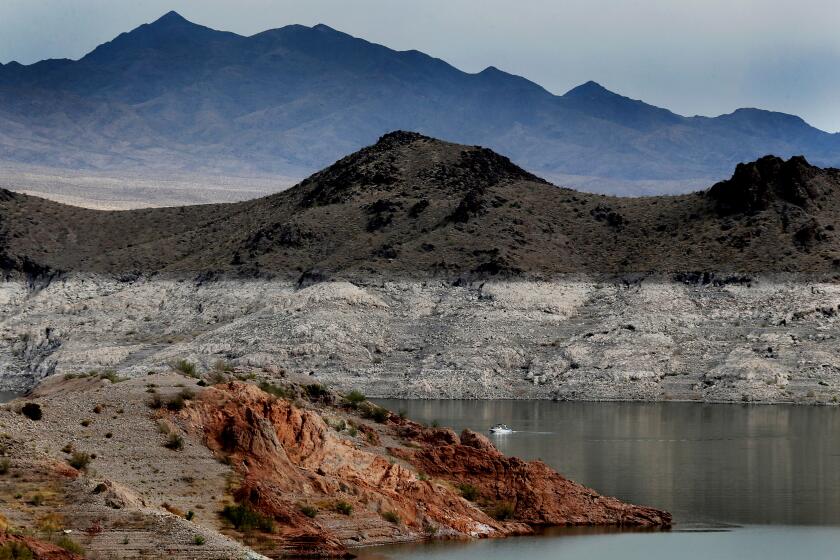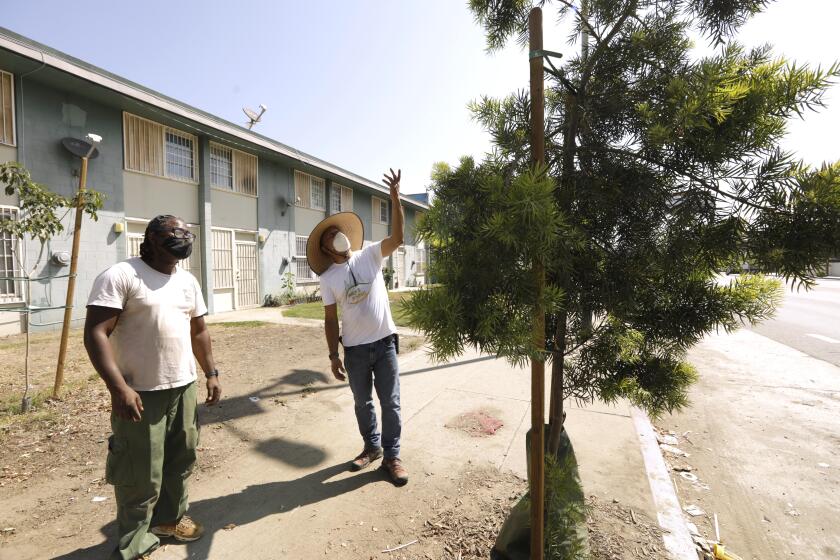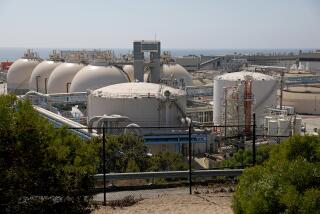In face of recurring drought, cities seek security in wastewater recycling projects

- Share via
When it comes to slaking Southern California’s colossal thirst for water, more and more local governments are searching their own sewer lines for a solution.
In the face of dire drought, cities and water agencies are now investing heavily in large-scale wastewater recycling facilities — systems that will purify the billions of gallons of treated sewage that are currently flushed out to sea.
Among the massive water recycling initiatives now under development in Los Angeles County are a $3.4-billion plant at the Joint Water Pollution Control Plant in Carson and Operation Next — a roughly $16-billion plan from the Los Angeles Department of Water and Power to purify up to 100% of the wastewater processed by the Hyperion Water Reclamation Plant and put it to good use.
“Our goal is really to turn the largest discharge of treated wastewater in Southern California into an engine for groundwater replenishment,” said Brad Coffey, of the Metropolitan Water District of Southern California. “That’s in an attempt to interrupt, break the snowpack-dependent water cycle of much of California and much of the West … that’s threatened by climate change.”
Years ago, scientists said climate change would bring a Colorado River crisis. Their warnings, which largely went unheeded, are now playing out.
The push to recycle municipal wastewater so that it could be added to reservoirs, underground aquifers and even municipal water lines began during the state’s last severe drought. Among other benefits, water managers say wastewater recycling will reduce the region’s dependence on water imported from Northern California or the Colorado River.
The statewide potential for water recycling is huge. Only 23% of California’s wastewater is currently recycled. In the South Coast hydrologic region — which includes Los Angeles and half the state’s population — the rate of recycling is slightly higher at 29%, according to a report by the Pacific Institute, a water think tank in Oakland.
That leaves 1.1 million acre-feet per year, or about 981 million gallons per day, of untapped wastewater in the South Coast region that could potentially be recycled after accounting for water needed to maintain river flows or discharged for environmental purposes, experts say.
The primary hurdle to building out massive water recycling projects, however, has been the way in which sewer systems are organized.
“We have built a very highly centralized system, and it’s sort of a once through system,” said Heather Cooley, director of research at the Pacific Institute. “We often build recycled wastewater treatment facilities at a low point in the watershed … and all the pipes are sort of oriented towards that.”
Recurring drought and rising temperatures have already begun to alter the landscape of California and the American Southwest, researchers warn.
But instead of treating wastewater and discharging it into the ocean, agencies must consider new pipes and delivery systems for pumping the purified water to various locations, whether it’s for groundwater recharge or nonpotable reuse.
This also highlights the collaboration needed between various groups, which is at odds with the “fragmentation” of water in our current system.
“In many instances, there is a water provider and a wastewater provider and those are separate groups,” Cooley said. “The folks who are getting the recycled wastewater are not folks that are providing water to the community typically.”
The Joint Water Pollution Control Plant in Carson discharges 260 million gallons of treated wastewater per day, treating sewage from as far away as Pomona. It’s an efficient operation powered entirely by biogas that results from treating wastewater and solid waste. Excess energy is sold to the local power grid.
Currently, the MWD operates a half-million gallon a day demonstration facility there. Ultimately, it hopes to run a full-scale plant that will eventually supply 150 million gallons of water per day — enough to supply more than 500,000 homes.
Water agencies in southern Nevada and central Arizona have contributed funds to the environmental planning process underway in hopes that Southern California’s decreased reliance on Colorado River water means more of that water left for their use, Coffey said. Federal officials have asked the Western states that rely on the river to drastically cut the water they take due to critically low levels at Lake Mead and Lake Powell, the country’s two largest reservoirs.
A 2018 cost estimate found the full-scale project would come out to be $3.4 billion with an additional $129 million a year for maintenance and operations, though an updated estimate will probably be higher. Construction is expected to begin in 2024 and end in 2031, with the plant up and running by the following year.
The new wastewater recycling facility planned for Hyperion should begin operation by 2035, Los Angeles city officials say. Currently, Hyperion only treats wastewater to the level necessary to release into Santa Monica Bay. The advanced water purification facility, however, will produce water clean enough to drink and process up to 230 million gallons of water a day.
“It’s such a heavy lift because it’s such a large plant,” said Traci Minamide, chief operating officer for LA Sanitation and Environment. “It’s an enormous endeavor.”
In addition to the upgrades at Hyperion, however, the city has to build new pump stations, facilities for water storage, pipes and other necessary infrastructure for bringing the water where it needs to be.
L.A. City is relying on a network of neighborhood tree ambassadors and nonprofits to boost tree canopy in underserved neighborhoods. Will it work?
The water that comes out of these treatment plants will be so clean, minerals must be added so that people can drink it.
The purification process will involve multiple steps:
First is the membrane bioreactor process, during which microorganisms break down the toxic nitrogen compounds, such as ammonia, that remain in treated wastewater, turning them into nitrates and eventually into harmless nitrogen gas.
Next, bundles of straw-like membranes filter the water through holes smaller than 1/100 of a grain of sand. Reverse osmosis then removes more than 99% of all impurities such as bacteria, pharmaceuticals and salts.
Finally, ultraviolet light and an oxidant create “free radicals” that fly around and destroy any viruses or chemical compounds that manage to make it through, slicing through them like a machete.
It’s a similar process to the one employed by the Albert Robles Center for Water Recycling and Environmental Learning, in Pico Rivera, since 2019. (The center uses a process called ultrafiltration, while the Carson and Hyperion plants will use a membrane bioreactor system, which is still being tested and awaiting formal approval.)
The facility takes water from treatment plants in Whittier and Pomona and can purify 14.8 million gallons of water per day. It is operated by the Water Replenishment District of Southern California, the little-known agency that manages water rights to aquifers beneath southern Los Angeles County.
Since 1962, the WRD has used a mix of recycled and imported water to replenish regional groundwater supplies. With the construction of the Albert Robles Center, however, the agency now uses 100% recycled water to replenish the same aquifers.
Now, the agency is looking to help others reach water self-sufficiency.
They’ve been working on a joint master plan with the city of Los Angeles for their Operation Next initiative to look at how to get purified recycled water from Hyperion into local aquifers.
They’re also working with MWD to figure out what to do with all the recycled water produced by the advanced purification plant in Carson once it’s in operation.
The eventual production of billions of gallons of recycled wastewater raises many issues that still need to be worked out, said Rob Beste, assistant general manager and chief operating officer of WRD.
“What are all your conveyance options? How big do they need to be? Where would you put it?” Beste asked. “And then you have to look at your demand side — how much water do you need in certain areas, where could you pump it out, where could you put it in your system?”










